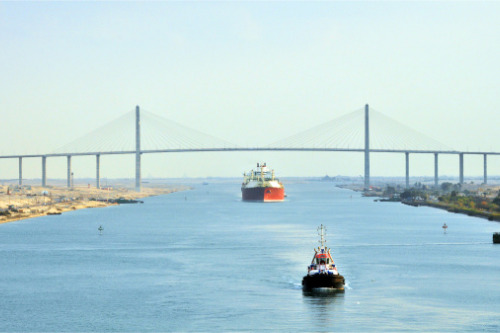

One of the world’s largest container ships – the 400-metre, 224,000-ton Ever Given – became lodged in the Suez Canal during strong winds and a sandstorm on March 23. The giant vessel was stuck at an angle, blocking the critical trade route for six days until she was re-floated and freed. While traffic through the canal – through which about 15% of all global shipping passes - resumed on March 29, global shipping logistics, supply chains, and insurers will likely feel the impact of the event for weeks to come.
The blockage could affect a number of marine insurance coverages, including but not limited to hull & machinery and protection & indemnity. DBRS Morningstar recently published a commentary, titled ‘The Suez Canal Blockage Is Likely to Have a Limited Impact on the Global Insurance Industry,’ in which the firm said insured losses should remain manageable given the relatively short duration of the blockage, the low prevalence of delay cargo insurance, and the common use of deductibles in marine policies.
Marcos Alvarez, senior vice president and head of insurance at DBRS Morningstar, commented: “The Suez Canal blockage could affect multiple insurance policies given the complexities of marine insurance and the number of parties involved. The first consideration is whether the ship itself sustained damage when it ran aground or during salvage operations. Litigation is likely to ensue to determine legal responsibility for the Ever Given blocking the canal. As of now, indications are that the responsible partners would include the owner of the ship, its operator, and the Suez Canal Authority, which requires local pilots to guide ships through the canal.”
On Tuesday, April 06, Suez Canal chief Lt. Gen. Osama Rabie told The Associated Press that authorities are negotiating a financial settlement with Shoei Kisen Kaisha Ltd., the Japanese owner of the Ever Given. They hope to reach a “peaceful resolution to the matter without resorting to the judiciary” – but that doesn’t mean that other claims and legal disputes won’t arise from the incident.
According to Fitch Ratings, accidents involving large container ships can cause property claims of over US$1 billion. These losses are mostly related to salvage, which would be borne by the shipowner’s hull insurer. In the case of the Ever Given, the vessel was actually freed relatively quickly (in six days), and it was able to move safely to one of the Suez Canal’s holding lakes, where authorities and the ship’s managers say an investigation is ongoing. It is believed that claims related to hull and cargo insurance, including salvage, should remain significantly below $1billion.
“However, the shipowner’s protection and indemnity club will probably also face claims from the owners of the cargo on the Ever Given and of the other ships that are blocked in the Suez Canal for losses related to perishable goods and supply chain disruptions,” Fitch Ratings added. “In addition, they may face claims from the Suez Canal Authority itself for loss of revenues.”
The reinsurance industry is likely to take the largest share of losses from the incident. The global ratings agency said: “This event will reduce global reinsurers’ earnings but should not materially affect their credit profiles, while prices for marine reinsurance will rise further as a consequence of the container ship Ever Given grounding in the canal.”
It will not be possible to understand the true impact of the Ever Given grounding until a formal investigation is complete. Suez Canal chief Rabie said last Tuesday that investigators had analyzed data from the Voyage Data Recorder – the vessel’s black box - but no conclusion had yet been reached on what led the mega ship to run aground.
“This is still to be investigated,” said Rahul Khanna, global head of marine risk consulting, at Allianz Global Corporate & Specialty (AGCS). “Most reports note that the vessel ran aground after being caught in strong winds and a sandstorm that caused poor visibility and made it difficult to navigate, although human error or machinery breakdown can also not be ruled out at this stage.
“Wind can cause problems for fully-loaded ultra large container ships, given the height of the container stacks, providing an extensive so-called ‘windage area’ compared to other ship-types. Cross winds can easily cause small deviations in a vessel’s course, which can bring issues in a relatively narrow waterway such as the canal. The bigger the vessel, the smaller the margin for error. The “bank effect” could have also played a role in the grounding where a suction effect towards the banks of a narrow canal is experienced by a large vessel. However, we have to wait for the findings of the official investigation to determine the root cause of this incident […] It is important at this stage to not speculate on the cause.”
